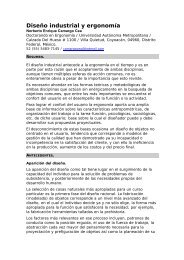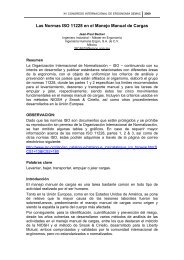ERGONOMÍA OCUPACIONAL - SOCIEDAD DE ERGONOMISTAS ...
ERGONOMÍA OCUPACIONAL - SOCIEDAD DE ERGONOMISTAS ...
ERGONOMÍA OCUPACIONAL - SOCIEDAD DE ERGONOMISTAS ...
You also want an ePaper? Increase the reach of your titles
YUMPU automatically turns print PDFs into web optimized ePapers that Google loves.
Ergonomía Ocupacional. Investigaciones y Aplicaciones. Vol 3 2010<br />
1. Introduction<br />
The work doing by the hands has been a very important factor on manufacturing industries,<br />
especially on development countries, but the human being and its physical characteristics at<br />
service of material transformation on industrial process it is not an endless power supply, while<br />
time passthrough the day, physical performance could be affected and modified.<br />
As a result of frequent exposure to work there is a risk of musculoskeletal injuries, Bernard et al<br />
(1997) refers that it´s “were recognized as having occupational etiologic factors as early as the<br />
beginning of the 18th century,however, it was not until the 1970s that occupational factors were<br />
examined using epidemiologic methods, and the work-relatedness of these conditions began<br />
appearing regularly in the international scientific literature. Since then the literature has increased<br />
dramatically; more than six thousand scientific articles addressing ergonomics in the workplace<br />
have been published. Yet, the relationship between MSDs and work-related factors remains the<br />
subject of considerable debate.”<br />
To understand the musculoskeletal disorders problem, is required to identify the risk factors<br />
associated to these kinds of injuries. There is a wide literature about it and its don´t surprise, the<br />
problem has been studied for years and many point of views and results of research converge on<br />
the causes or risk factors, Colombini (1998) recognize mainly four risk factors; repetitive<br />
movements (frequency), force applied to the task, awkward postures and lack of enough recovery<br />
time on each work cycle. Muggleton (1999) includes vibration as a risk factor for the hand-wrist.<br />
McAtamney y Corlet (1973) refers to the risk factors as external factors, including a consideration<br />
for static work load on muscles. Furthermore, highly repetitive work may directly damage tendons<br />
through repeated stretching and elongation, as well as increase the likelihood of fatigue and<br />
decrease the opportunity for tissues to recover Keyserlin et al (1993).<br />
This work is focused in finding the relationship between frequency and the force that people can<br />
exert as a function of time and some anthropometric characteristics, the approach is; on the latest<br />
hours of the shift work, force become to decrease significant, at least statistically and there is a<br />
relationship between force and anthropometrics.<br />
2. Method<br />
One objective was collect data in working conditions, so the “experiment” was planned as follows:<br />
Sociedad de Ergonomistas de México, A.C. 56




